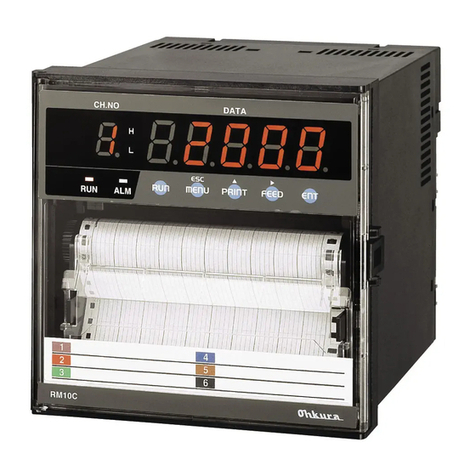
―4―HXPRM10mnC0001E
CONTENTS
1. INTRODUCTION...................................................................6
1.1 CheckingtheAccessories............................................................6
1.2 CheckingtheTypeandSpecifications.........................................7
1.3 TemporaryStorage.......................................................................8
1.4 IndicationCard..............................................................................8
2. CONSTRUCTION..................................................................9
2.1 Appearance ................................................................................9
2.2 DisplayScreenandOperationKeys..........................................10
2.2.1 DisplayScreen......................................................................10
2.2.2 OperationKeys.....................................................................11
3. INSTALLATION.................................................................. 12
3.1 OutsideDimensions Drawing
andPanelCuttingDimensions..................................................12
3.2 MountingtothePanel.................................................................13
3.2.1 ProcedureforMountingtothePanel...................................13
3.2.2 MountingtothePanel incompliancewiththe IP65............14
4. WIRING................................................................................ 15
4.1 TerminalLayoutandPowerWiring............................................15
4.1.1 TerminalLayout.....................................................................15
4.1.2 PowerWiring.........................................................................15
4.1.3 WiringProcedure..................................................................16
4.2 InputWiring.................................................................................17
4.2.1 WiringProcedure..................................................................18
4.3 DI/Alarm OutputWiring(Option)................................................20
4.3.1 DI/Alarm OutputWiringExample.........................................20
4.3.2 Alarm OutputWiringProcedure...........................................21
4.3.3 DIWiringProcedure.............................................................21
4.4 CommunicationWiring...............................................................22
4.4.1 RS-232CWiring....................................................................22
4.4.2 RS-485Wiring.......................................................................22
5. PREPARATIONS FOR OPERATION .............................. 23
5.1 SettingtheChartPaper..............................................................23
5.2 SettingtheRibbonCassette.......................................................29
6. OPERATION....................................................................... 31
6.1 Operation.....................................................................................31
6.1.1 StatusafterInitialScreen......................................................31
6.2 Recording....................................................................................32
6.2.1 RecordingColors..................................................................32
6.3 Howto Record............................................................................32
6.3.1 Starting/Stopping Recording Operation...............................32
6.3.2 FeedtheChartPaper...........................................................32
6.3.3 Print Sample..........................................................................33
6.4 DigitalPrint...................................................................................34
6.4.1 ManualPrint..........................................................................34
6.4.2 ListPrint.................................................................................35
6.4.3 EngineeringListPrint............................................................37
6.4.4 RecordStart/EndPrint .........................................................39
6.4.5 DIManual Print......................................................................39
6.4.6 DIDate/TimePrint.................................................................39
6.4.7 DICommentPrint.................................................................40
6.5 ChangingtheDisplay ................................................................41
6.5.1 AutoDisplay < >.....................................................41
6.5.2 ManualDisplay < >....................................................41
6.5.3 DateDisplay< >.....................................................41
6.5.4 TimeDisplay < >....................................................41
6.5.5 DisplayOff< >............................................................41
7. DEVICE SETTING..............................................................42
7.1 SettingtheSetupMode..............................................................42
7.1.1 SettingtheRange.................................................................45
(1) Settingmethod.....................................................................45
(2) (Current/Voltage), (Thermocouple),
(ResistanceTemperatureDetector)........................46
(3) (Scaling)............................................................48
(4) (SquareRoot).......................................................50
(5) (Decade)...........................................................52
(6) (Difference) (Sum),
(Average).............................................................. 54
(7) (Skip).....................................................................55
7.1.2 SettingtheAlarm..................................................................56
7.1.3 SettingtheUnit.....................................................................58
(1) CharacterCodeTable..........................................................59
7.1.4 SettingtheChartSpeed....................................................... 60
7.1.5 SettingtheDateandTime...................................................61
7.1.6 CopyingtheSettingData.....................................................62
7.1.7 SettingOtherFunctions........................................................63
(1) (Printing Cycle).................................................64
(2) (ZoneRecording).................................................64
(3) (PartialCompression/Expansion).......................65
(4) (DigitalPrint)..................................................... 66
(5) (Tag)..........................................................................67
(6) (CommentWords)............................................... 68
7.2 SettingtheEngineeringMode...................................................69
7.2.1 Alarm Hysteresis...................................................................72
7.2.2 BurnoutON/OFF.................................................................. 72
7.2.3 Channel Offset......................................................................72
7.2.4 ReferenceJunctionCompensation.....................................73
7.2.5 Changingthe PrintingColor ................................................ 74
7.2.6 SettingsRelatedtoRecording............................................. 75
(1) Recording start/stoptriggersetting......................................75
(2) Tag/channelprintselection..................................................75
(3) Alarm printON/OFF.............................................................76
(4) Loggingprint ON/OFF.........................................................76
(5) Scaleprint ON/OFF............................................................. 77
(6) Loggingprint Synchronous/Asynchronous........................78
7.2.7 SettingtheCommunicationFunction..................................78
7.2.8 Initializing theSetup Data ....................................................79
7.2.9 DIFunctions..........................................................................79
7.2.10 TemperatureUnit................................................................80
7.2.11 Point Calibration..................................................................80
7.2.12 Data Calibration..................................................................82
7.3 TerminatingtheEngineeringMode............................................84





























